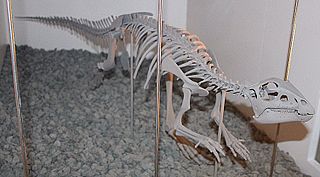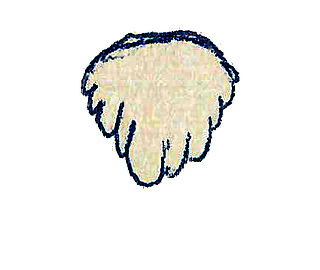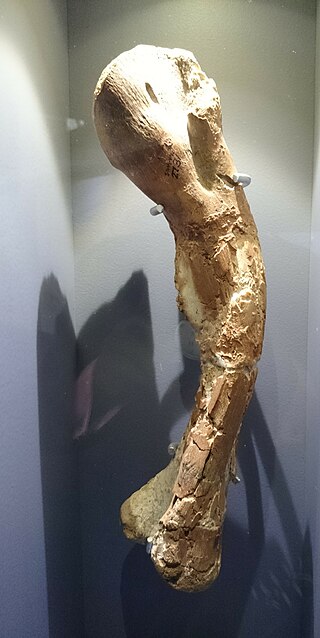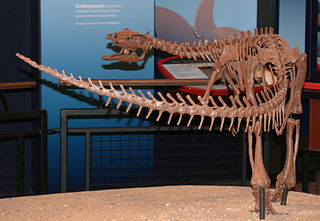Related Research Articles

Hypsilophodontidae is a traditionally used family of ornithopod dinosaurs, generally considered invalid today. It historically included many small bodied bipedal neornithischian taxa from around the world, and spanning from the Middle Jurassic until the Late Cretaceous. This inclusive status was supported by some phylogenetic analyses from the 1990s and mid 2000s, although there have also been many finding that the family is an unnatural grouping which should only include the type genus, Hypsilophodon, with the other genera being within clades like Thescelosauridae and Elasmaria. A 2014 analysis by Norman recovered a grouping of Hypsilophodon, Rhabdodontidae and Tenontosaurus, which he referred to as Hypsilophodontia. All other analyses from around the same time have instead found these latter taxa to be within Iguanodontia.
Callovosaurus is a genus of iguanodontian dinosaur known from most of a left thigh bone discovered in Middle Jurassic-age rocks of England. At times, it has been considered dubious or a valid genus of basal iguanodontian, perhaps a dryosaurid.

Yaverlandia is a genus of maniraptoran dinosaur. Known from a partial fossil skull found in Lower Cretaceous strata of the Wessex Formation on the Isle of Wight. it was described as the earliest known member of the pachycephalosaurid family, but research by Darren Naish shows it to have actually been a theropod, seemingly a maniraptoran. The type species is Y. bitholus.

Alocodon is a genus of ornithischian dinosaur known from multiple teeth from the Middle or Late Jurassic. The taxon was first described in 1973 by Richard A. Thulborn for an assemblage of teeth from the Pedrógão locality of Portugal, distinguished by an enlarged central denticle on the teeth, with the name taken from the Greek alox and odon meaning 'furrow tooth'. The type specimen, a single tooth, is stored in the Museu Geológico do Instituto Geológico e Mineiro in Lisbon, Portugal, formerly having been kept in the collections of the Free University of Berlin as IPFUB P X 1, and comes from an individual under 2 m (6.6 ft) in length. Though it was originally described as having been found in an unnamed deposit in the Portuguese Leiria District of upper Callovian age, it was identified as having come from the lower Oxfordian Cabaços Formation. Alongside the 158 isolated teeth from Portugal assigned to Alocodon, some isolated teeth from the Bathonian Forest Marble and Chipping Norton Formations of England have been assigned to as cf. Alocodon sp. based on similarity.

Barsboldia is a genus of large hadrosaurid dinosaur from the early Maastrichtian Nemegt Formation of Ömnogöv', Mongolia. It is known from a partial vertebral column, partial pelvis, and some ribs.
Trimucrodon is a genus of ornithischian dinosaur from the Late Jurassic of Portugal. Three isolated teeth found at the Porto Dinheiro locality in the Lisboa District of Portugal were given the name in 1973 by Richard A. Thulborn, derived from the Latin words for "three" and a dagger point, tri- and mucro, and the Ancient Greek word ὀδούς for "tooth". The only species in the taxon is Trimucrodon cuneatus, taken from the wedge shape of the teeth. Though the unit the specimens came from was originally unnamed, it was referred to the Alcobaça, and then Lourinhã Formations, specifically the late Kimmeridgian Amoreira–Porto Novo Member. The type specimen, uncovered between 1962 and 1967 by German zoologist and paleontologist Georg Krusat, is distinguished by prominent denticles at the front and rear ends of the crown, and comes from an individual under 2 m (6.6 ft) long. It is currently kept in the collections of the Museu Geológico do Instituto Geológico e Mineiro in Lisbon, Portugal, formerly having been kept in the collections of the Free University of Berlin.
Taveirosaurus (tah-VAY-roo-SAWR-us) is a genus of ornithischian dinosaur that lived in Europe during the Late Cretaceous. The genus is based solely on teeth.

Kangnasaurus is a genus of iguanodontian ornithopod dinosaur found in supposedly Early Cretaceous rocks of South Africa. It is known from a tooth and possibly some postcranial remains found in the early-Aptian Kalahari Deposits Formation. It was probably similar to Dryosaurus.
Gongbusaurus is a genus of ornithischian, perhaps ornithopod, dinosaur that lived between about 160 and 157 million years ago, in the Late Jurassic period. A small herbivore, it is very poorly known. Two species have been assigned to it, but as the original name is based on teeth, there is no concrete evidence to connect the two species. Its fossils have been found in China.

Heterodontosauridae is a family of ornithischian dinosaurs that were likely among the most basal (primitive) members of the group. Their phylogenetic placement is uncertain but they are most commonly found to be primitive, outside of the group Genasauria. Although their fossils are relatively rare and their group small in numbers, they have been found on all continents except Australia and Antarctica, with a range spanning the Early Jurassic to the Early Cretaceous.

Saurischia is one of the two basic divisions of dinosaurs, classified by their hip structure. Saurischia and Ornithischia were originally called orders by Harry Seeley in 1888 though today most paleontologists classify Saurischia as an unranked clade rather than an order.

Dryosauridae was a family of primitive iguanodonts, first proposed by Milner & Norman in 1984. They are known from Middle Jurassic to Early Cretaceous rocks of Africa, Europe, and North America.

The palpebral bone is a small dermal bone found in the region of the eye socket in a variety of animals, including crocodilians and ornithischian dinosaurs. It is also known as the adlacrimal or supraorbital, although the latter term may not be confused with the supraorbital in osteichthyan fishes. In ornithischians, the palpebral can form a prong that projects from the front upper corner of the orbit. It is large in heterodontosaurids, basal ornithopods such as Thescelosaurus and Dryosaurus, and basal ceratopsians such as Archaeoceratops; in these animals, the prong is elongate and would have stuck out and over the eye like a bony eyebrow. As paleoartist Gregory S. Paul has noted, elongate palpebrals would have given their owners fierce-looking "eagle eyes". In such cases, the expanded palpebral may have functioned to shade the eye.

Halszka Osmólska was a Polish paleontologist who had specialized in Mongolian dinosaurs.
Teresa Maryańska was a Polish paleontologist who specialized in Mongolian dinosaurs, particularly pachycephalosaurians and ankylosaurians. Peter Dodson states that in 1974 Maryanska together with Halszka Osmólska were among the first "women to describe new kinds of dinosaurs". She is considered not only as one of Poland's but also one of the world's leading experts on dinosaurs.
John Sibbick is a British freelance illustrator and palaeoartist, known for his depictions of prehistoric life and for his fantasy art.
The Paw Paw Formation is a geological formation in Texas whose strata date back to the late Albian stage of the Early Cretaceous. Dinosaur remains are among the fossils that have been recovered from the formation.
The El Picacho Formation is a geological formation in Texas, United States, whose strata date back to the Late Cretaceous. Dinosaur remains are among the fossils that have been recovered from the formation. The paleosols found here are rich in clay, calcite, and rhizoliths which show that during the Cretaceous period, this fossil formation, just like the neighboring Javelina Formation and Aguja Formation, was a fluvial flood plain.

Thescelosauridae is a clade of neornithischians from the Cretaceous of Asia, North America and possibly South America. The group was originally used as a name by Charles M. Sternberg in 1937, but was not formally defined until 2013, where it was used by Brown and colleagues as the group uniting Thescelosaurus and Orodromeus, based on their phylogenetic results. During a phylogenetic revision of neornithischians by Clint Boyd in 2015, the authorship of Thescelosauridae was given to Brown and colleagues, which meant that the similar name Parksosauridae, informally defined in 2002 by Buchholz, would have had priority over Thescelosauridae. The two clades had slightly different definitions, with Parksosauridae referring to all animals closer to Parksosaurus than Hypsilophodon, but they contained the same taxa so Boyd used Parksosauridae under the assumption it had priority. However, in formalizing the clade following the regulations of the PhyloCode, Madzia, Boyd, and colleagues identified in 2021 that Sternberg was the proper authority for Thescelosauridae, giving it priority over Parksosauridae. As well, they gave Thescelosauridae the definition of the largest clade containing Thescelosaurus neglectus but not Iguanodon bernissartensis, as long as Hypsilophodon foxii was not in the group, modifying previous definitions for Thescelosauridae in order to maintain its modern use, so that the clade was not applied if Thescelosaurus fell within Hypsilophodontidae, a family that has not been recently used but may be revived if the systematic position of Hypsilophodon was solidified at some point in the future. Madzia et al. identified the analysis of Madzia et al. in 2018 as the reference analysis for the name Thescelosauridae, an analysis based on a revised version of the 2015 Boyd analysis.
The Kalahari Deposits is an Early Cretaceous (Aptian) geologic formation in South Africa. Dinosaur remains diagnostic to the genus level are among the fossils that have been recovered from the formation. The depositional environment is described as a crater lake where poorly lithified, concretionary conglomerate and volcaniclastic, intraclastic, calcareous mudstone were deposited under quiet subaqueous conditions, probably a "crater-fill succession above an olivine-melilitie intrusion".
References
- ↑ "Sedgwick Museum of Earth Sciences - Staff". Sedgwick Museum.
- ↑ University of Cambridge / Department of Earth Sciences / People / Professor David Norman / Biography
- ↑ "| Reg. Charity No. 1168330". The Palaeontological Association .
- ↑ "Norman David B". Archived from the original on 1 December 2008. Retrieved 28 January 2010.
- ↑ You, Hai-lu; Luo, Zhe-xi; Shubin, Neil H.; Witmer, Lawrence M.; Tang, Zhi-lu; Tang, Feng (June 2003). "The earliest-known duck-billed dinosaur from deposits of late Early Cretaceous age in northwest China and hadrosaur evolution" (PDF). Cretaceous Research. 24 (3): 347–355. doi:10.1016/S0195-6671(03)00048-X.
- ↑ Baron, Matthew G.; Norman, David B.; Barrett, Paul M. (23 March 2017). "A new hypothesis of dinosaur relationships and early dinosaur evolution". Nature. 543 (7646): 501–506. Bibcode:2017Natur.543..501B. doi:10.1038/nature21700. PMID 28332513. S2CID 205254710.
- ↑ Professor David Norman FLS (MA Cantab), Christ's College - University of Cambridge